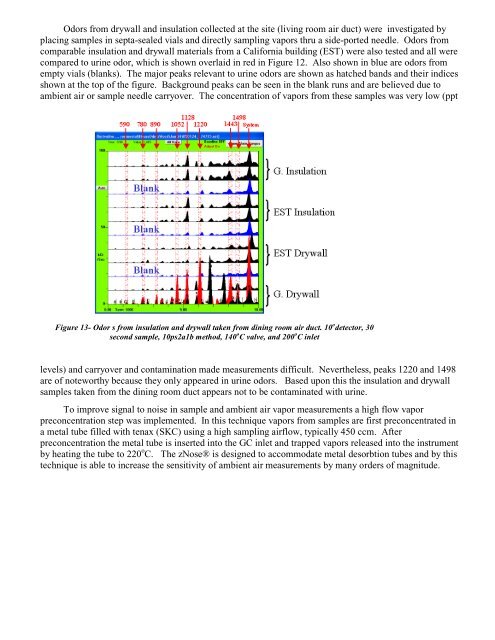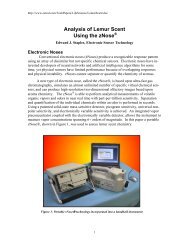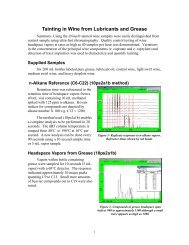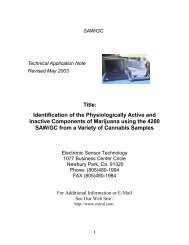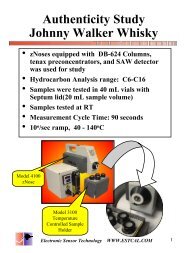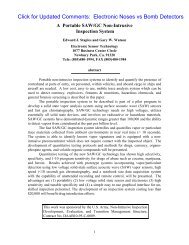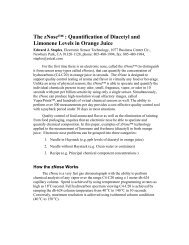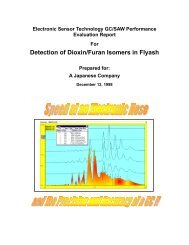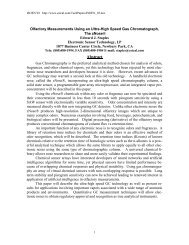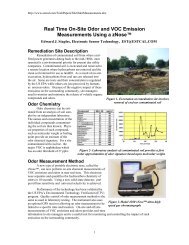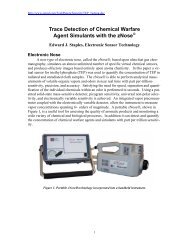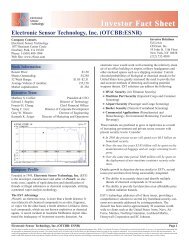Urine Odors in an Urban Dwelling - Electronic Sensor Technology
Urine Odors in an Urban Dwelling - Electronic Sensor Technology
Urine Odors in an Urban Dwelling - Electronic Sensor Technology
Create successful ePaper yourself
Turn your PDF publications into a flip-book with our unique Google optimized e-Paper software.
<strong>Odors</strong> from drywall <strong>an</strong>d <strong>in</strong>sulation collected at the site (liv<strong>in</strong>g room air duct) were <strong>in</strong>vestigated by<br />
plac<strong>in</strong>g samples <strong>in</strong> septa-sealed vials <strong>an</strong>d directly sampl<strong>in</strong>g vapors thru a side-ported needle. <strong>Odors</strong> from<br />
comparable <strong>in</strong>sulation <strong>an</strong>d drywall materials from a California build<strong>in</strong>g (EST) were also tested <strong>an</strong>d all were<br />
compared to ur<strong>in</strong>e odor, which is shown overlaid <strong>in</strong> red <strong>in</strong> Figure 12. Also shown <strong>in</strong> blue are odors from<br />
empty vials (bl<strong>an</strong>ks). The major peaks relev<strong>an</strong>t to ur<strong>in</strong>e odors are shown as hatched b<strong>an</strong>ds <strong>an</strong>d their <strong>in</strong>dices<br />
shown at the top of the figure. Background peaks c<strong>an</strong> be seen <strong>in</strong> the bl<strong>an</strong>k runs <strong>an</strong>d are believed due to<br />
ambient air or sample needle carryover. The concentration of vapors from these samples was very low (ppt<br />
Figure 13- Odor s from <strong>in</strong>sulation <strong>an</strong>d drywall taken from d<strong>in</strong><strong>in</strong>g room air duct. 10 o detector, 30<br />
second sample, 10ps2a1b method, 140 o C valve, <strong>an</strong>d 200 o C <strong>in</strong>let<br />
levels) <strong>an</strong>d carryover <strong>an</strong>d contam<strong>in</strong>ation made measurements difficult. Nevertheless, peaks 1220 <strong>an</strong>d 1498<br />
are of noteworthy because they only appeared <strong>in</strong> ur<strong>in</strong>e odors. Based upon this the <strong>in</strong>sulation <strong>an</strong>d drywall<br />
samples taken from the d<strong>in</strong><strong>in</strong>g room duct appears not to be contam<strong>in</strong>ated with ur<strong>in</strong>e.<br />
To improve signal to noise <strong>in</strong> sample <strong>an</strong>d ambient air vapor measurements a high flow vapor<br />
preconcentration step was implemented. In this technique vapors from samples are first preconcentrated <strong>in</strong><br />
a metal tube filled with tenax (SKC) us<strong>in</strong>g a high sampl<strong>in</strong>g airflow, typically 450 ccm. After<br />
preconcentration the metal tube is <strong>in</strong>serted <strong>in</strong>to the GC <strong>in</strong>let <strong>an</strong>d trapped vapors released <strong>in</strong>to the <strong>in</strong>strument<br />
by heat<strong>in</strong>g the tube to 220 o C. The zNose® is designed to accommodate metal desorbtion tubes <strong>an</strong>d by this<br />
technique is able to <strong>in</strong>crease the sensitivity of ambient air measurements by m<strong>an</strong>y orders of magnitude.


